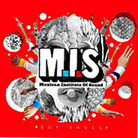Fresh from teaching a course about literary adaptations and borrowings, I’m now wrangling with an article on that topic this summer. Whatever this says about me, I’m very interested in non-originality: in the degree and manner by which people creatively rework old material—borrow, pillage, plunder, re-use, recycle, and in general put vino nuevo en cueros viejos. This is the new-media question of the moment: should creative expression be thought of as a kind of open-source code, where authorship is not individual but collective, accreting layers of new, sedimented meaning over time? Looked at a certain way, without the fetish of the individual genius that is our legacy from the Romantics, couldn’t this be the very model of literary and cultural history? (Of course, when you insist that the borrowed matter is “your own,” you’re not only reverting to that earlier notion of authorship-as-possession but guilty of plagiarism—I was incredulous that some of the students in my adaptation class would miss that point and rip stuff off the internet anyway, but that’s another story.)
So I was delighted to discover (that seems like the wrong word, since it came to my consciousness from a Facebook link) that the new NPR podcast, Alt-Latino, had a great show called “Rescued and Refurbished: Our Favorite Latin Rock Remakes.” Terms like “cover” and “remake” don’t quite capture the multiple nests of attribution and referencing here, especially when the versions move, partway or all the way, between languages, like Seu Jorge’s Portuguese rendition of David Bowie’s “Life on Mars.” Then there are all the interpretive spins that come when you move across genres and styles, like the transformation of the misogynistic cumbia “Baracunatana” into a fem-rock anthem in Andrea Echeverri’s rendition. Those transformations often weave a path, in their musical preferences, across ethno-national lines: this, more than ambivalent acculturation into/by USAmericanness, is what makes Latino culture.
My favorite find on the show is the last thread, which follows The Verve’s megahit “Bitter Sweet Symphony,” inescapable in 1997, both backward in time (to its orchestration off a Stones song in the late 1960s) and forward– to its semi-translation into “Sinfonía agridulce” by the Mexican Institute of Sound, itself a perfect example of a band that cannily takes from both globalized mass culture and the particularity of folk and regional forms.
The Alt.Latino website notes, “It sounds as if lead singer Camilo Lara is stumbling out of a tavern,” but to me the recording was trying to get the effect of a casual group of musicians meeting in the street or in the plaza: you hear “Echale maestro” at the start and the obligatory “¡Je, je! ¡Viva México!” at the end, with the hand-clapping starting in the last several bars of the song and continuing beyond it. The famous violin line in the Oldham/Verve song is played in a deliberately non-virtuostic way; the typical horns are added in–to call this a sinfonía is completely ironic. Best of all, Lara’s very loose translation resolves the question over what Richard Ashcroft was mumbling in the “original” version (was it “here in my mold”? or “here in my mind?”): estoy aquí en mi mero mole. I’m here in my own thing, right where I want to be, and my despair is delicious. That state of musical affect called “tortured” comes off differently when you have Mexico behind you. It’s more . . . saucy.
